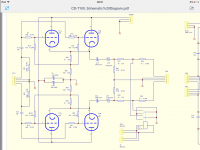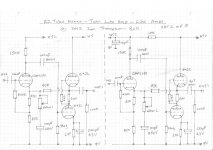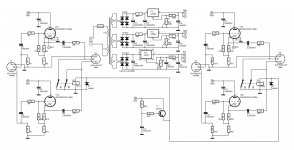Hi everyone.
Id like to experiment with a tube input stage in front of my ice power amps but I know nothing about tubes.
Are there any good designs/boards/kits available to get started with?
Only requirement I have is balanced input.
Id like to experiment with a tube input stage in front of my ice power amps but I know nothing about tubes.
Are there any good designs/boards/kits available to get started with?
Only requirement I have is balanced input.
How much gain do you need and what input impedance has the ice power amps?
There are a lot of input buffers on this forum.
There are a lot of input buffers on this forum.
Last edited:
This question comes up so often.
Most class D amps have lots of gain, and don't need any more.
Adding a tube in front usually means adding some gain. But you don't need any gain. So why do you want the tube?
What do you want to get from the tube? What do you expect it to do?
Most class D amps have lots of gain, and don't need any more.
Adding a tube in front usually means adding some gain. But you don't need any gain. So why do you want the tube?
What do you want to get from the tube? What do you expect it to do?
Magic.
Pride.
Fairy dust.
Certainly nothing you can hear, definitely not in a unity gain "Line Stage" passing 1 or 2 V RMS through it.
Line stages were designed to drive long lines (duh!!!) in the most transparent way, not sure about their usefulness driving a couple feet cable, from a low source impedance high signal level Audio source, to an easy to drive mid/high impedance Amp input.
Maybe it´s the orange glow, that´s why a couple manufacturers add a couple strategically placed Red or Amber LEDs
But the T*** word still carries a lot of emotional weight to some.
Pride.
Fairy dust.
Certainly nothing you can hear, definitely not in a unity gain "Line Stage" passing 1 or 2 V RMS through it.
Line stages were designed to drive long lines (duh!!!) in the most transparent way, not sure about their usefulness driving a couple feet cable, from a low source impedance high signal level Audio source, to an easy to drive mid/high impedance Amp input.
Maybe it´s the orange glow, that´s why a couple manufacturers add a couple strategically placed Red or Amber LEDs
But the T*** word still carries a lot of emotional weight to some.
If you really want to "tubez-out" on your amplifier sound, you could run the signal through two 12AX7s, one for each channel, with the triode sections of each strapped; plate to plate, grid to grid, cathode to cathode. That'll put more of a bend in the amplification curve - and generate a "tubez" harmonic character for you.
You'll of course get some gain out of it, but that can be mitigated with divider networks on the I/O of the circuit, along with the plate and cathode resistor value choices.
Somewhere in the tube amp section of DIYAudio, someone posted a schematic of a modern commercial tube amp which does just that on its input 12AX7. My memory of the exact post fails me, but if you could find it, that'd be a starting point for component values and voltages needed.
And if it's all too much, you could always arrange it so one of the strapped triodes could be effectively disconnected, perhaps even with a switch. So you have two separate tubes for each channel with just one section used. That's been done too.
Edit: Oh, balanced input - I didnt read that before I opened my mouth. Guess it's 4 12AX7s then; one for the +, one for the -, two for each channel.
You'll of course get some gain out of it, but that can be mitigated with divider networks on the I/O of the circuit, along with the plate and cathode resistor value choices.
Somewhere in the tube amp section of DIYAudio, someone posted a schematic of a modern commercial tube amp which does just that on its input 12AX7. My memory of the exact post fails me, but if you could find it, that'd be a starting point for component values and voltages needed.
And if it's all too much, you could always arrange it so one of the strapped triodes could be effectively disconnected, perhaps even with a switch. So you have two separate tubes for each channel with just one section used. That's been done too.
Edit: Oh, balanced input - I didnt read that before I opened my mouth. Guess it's 4 12AX7s then; one for the +, one for the -, two for each channel.
Last edited:
Thank you all.
I dont really need any more gain.
Some high end amps use class d with a tube input stage so there has to be something to learn.
Yes. Balanced in- and output.Do you need balanced in and out?
The amps have input impedance of minimum 8kOhm.How much gain do you need and what input impedance has the ice power amps?
I dont really need any more gain.
Mostly Im just curious to experiment with tubes and see how it affects the sound.What do you want to get from the tube? What do you expect it to do?
Some high end amps use class d with a tube input stage so there has to be something to learn.
Class D amps were the tube buffer replace the first opampstage are a good solution. Often they use Class D amp(Oem) without opampbuffer.
But your ice amp already has the opampbuffer. To ad some tube harmonics you can use a common cathode follower like schematic below. Use stabelized 200v anode and heater supply.
For symmetrical signal build the schematic two times and use 20sec On delay.
You can use for C25/26 and C27/C28 a 2,2uf capacitor because of your high input impedance and leave out R49 and R50.
You can also use 1 triode for each signal path. Then you have only 2 tubes. Change then R36/ R39 from 47 to 100Ohm and R26/R28 from 470 to 1k.
If wanted i can search for the complete schematic i build 20 years ago?
But your ice amp already has the opampbuffer. To ad some tube harmonics you can use a common cathode follower like schematic below. Use stabelized 200v anode and heater supply.
For symmetrical signal build the schematic two times and use 20sec On delay.
You can use for C25/26 and C27/C28 a 2,2uf capacitor because of your high input impedance and leave out R49 and R50.
You can also use 1 triode for each signal path. Then you have only 2 tubes. Change then R36/ R39 from 47 to 100Ohm and R26/R28 from 470 to 1k.
If wanted i can search for the complete schematic i build 20 years ago?
Attachments
Last edited:
Since you want balanced in and balanced out then you could consider using input and output transformers for this. This will potential provide the additional mojo of using transformers as well as tubes. Don't skimp on the transformers; good 10K:10K input transformers are available from Sowter, Jensen, Cinemag and others. Carnhill make the best line level output transformers.
In between them you could use my twin line amp circuit (attached).
Cheers
Ian
In between them you could use my twin line amp circuit (attached).
Cheers
Ian
Attachments
You can set more feedback, so less distortion.This question comes up so often.
Most class D amps have lots of gain, and don't need any more.
Adding a tube in front usually means adding some gain. But you don't need any gain. So why do you want the tube?
What do you want to get from the tube? What do you expect it to do?
Yes these do, but many people do like that form of distortion who is only even harmonics putting
more body to the sound to get warmer sound output.
I myself have a hybrid amp without feedback, this do quite nice, for years now sounding fantastic,.
more body to the sound to get warmer sound output.
I myself have a hybrid amp without feedback, this do quite nice, for years now sounding fantastic,.
Here's one I posted about recently in a thread about line stages that use low Rp tubes:
I recently built this one using the Russian 6P43P-E (6CW5 / EL86). Mu is supposedly ~7 or 8 and output impedance is under 1k. Build cost was just under $100.






Details here: https://audiokarma.org/forums/index.php?threads/the-flow-pre4d-a-diy-tube-preamp.1084409/
Details here: https://audiokarma.org/forums/index.php?threads/the-flow-pre4d-a-diy-tube-preamp.1084409/
Technically, why the battery instead of, say, a cap bypassed 1.5K cathode resistor? Not that the battery wouldnt last any worse than shelf life.
Is it okay to build tube circuits on a wooden board without a ground?Here's one I posted about recently in a thread about line stages that use low Rp tubes:
I recently built this one using the Russian 6P43P-E (6CW5 / EL86). Mu is supposedly ~7 or 8 and output impedance is under 1k. Build cost was just under $100.






Details here: https://audiokarma.org/forums/index.php?threads/the-flow-pre4d-a-diy-tube-preamp.1084409/
Swedish older wooden houses did not need to have an earth.
In the uk we were always worried about having one hand on some metal (e.g. the radiator) and the other hand on some equipment with exposed mains voltages, so not only is there an earth, but all exposed metal items require their own earth straps.
In the case of the amplifier, there will also be a transformer providing galvanic isolation.
In the uk we were always worried about having one hand on some metal (e.g. the radiator) and the other hand on some equipment with exposed mains voltages, so not only is there an earth, but all exposed metal items require their own earth straps.
In the case of the amplifier, there will also be a transformer providing galvanic isolation.
If you read the build thread, which I linked, you’ll see that this is primarily designed to appeal to owners of cheap Chinese tube preamps, like the FX, who are modding them. The mod possibilities are quite limited and the tubes they use are not well suited for use with Class D / SS. The idea is to encourage them to get into DIY and build something from scratch instead.Technically, why the battery instead of, say, a cap bypassed 1.5K cathode resistor? Not that the battery wouldnt last any worse than shelf life.
My original plan was to use a resistor / bypass cap combo simply because it’s more familiar / commonly used. And some prospective builders might mistakenly think that the batteries would need to be changed regularly. I tried the resistor / bypass combo but when I switched to battery grid bias I thought it sounded much better. In the build thread I also have a schematic with a resistor / bypass cap and I encourage people to compare the two and use what sounds best to them.
I’ve been using battery grid bias on input tubes for a while now. I’m not very technically oriented, I just think it sounds better. If there is a technical basis for this I suspect the difference may be the elimination of the electrolytic cap.
- Home
- Amplifiers
- Tubes / Valves
- Tube input stage for Class D amp


